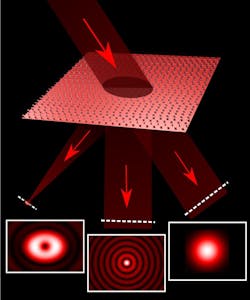More effective laser control possible via new metasurface system
A team at the Harvard John A. Paulson School of Engineering and Applied Sciences (SEAS; Cambridge, MA) has developed a single metasurface that tunes various properties of laser light, including wavelength. It does so without additional optical components.
Specifically, the metasurface splits light into multiple beams and “controls their shape and intensity in an independent, precise, power-efficient way.” According to the researchers, this breakthrough paves the way toward lightweight, more efficient optical systems for applications from quantum sensing to VR/AR.
A tunable laser, it comprises two components: a laser diode and a reflective metasurface. Traditional systems rely instead on a light-controlling network of individual pillars. The new system utilizes supercells—“groups of pillars which work together to control different aspects of light.” According to the researchers, when light from the diode hits the supercells on the metasurface, part of that light is reflected back. This in turn creates a laser cavity between the diode and the metasurface, while the remaining light reflects to a second beam independent from the first. To change the wavelength, the team “simply moves the metasurface with respect to the laser diode.”
The researchers note that precisely controlling properties of laser light is critical to current technologies and applications such as commercial VR headsets and microscopic imaging for biomedical research.
“Our approach paves the way to new methods to engineer the emission of optical sources and control multiple functions … in parallel in a single metasurface,” says Federico Capasso, the Robert L. Wallace Professor of Applied Physics and Vinton Hayes Senior Research Fellow in Electrical Engineering at SEAS and senior author of the paper. “In addition to controlling any type of laser, this ability to generate multiple beams in parallel and directed at arbitrary angles, each implementing a different function, will enable many applications from scientific instrumentation to augmented or virtual reality and holography.” Reference: C. Spägele et al., Nat. Commun., 12, 3787 (2021); https://doi.org/10.1038/s41467-021-24071-2.
About the Author
Justine Murphy
Multimedia Director, Digital Infrastructure
Justine Murphy is the multimedia director for Endeavor Business Media's Digital Infrastructure Group. She is a multiple award-winning writer and editor with more 20 years of experience in newspaper publishing as well as public relations, marketing, and communications. For nearly 10 years, she has covered all facets of the optics and photonics industry as an editor, writer, web news anchor, and podcast host for an internationally reaching magazine publishing company. Her work has earned accolades from the New England Press Association as well as the SIIA/Jesse H. Neal Awards. She received a B.A. from the Massachusetts College of Liberal Arts.

